Related Research Articles
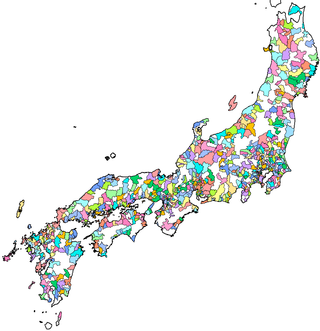
A city is a local administrative unit in Japan. Cities are ranked on the same level as towns and villages, with the difference that they are not a component of districts. Like other contemporary administrative units, they are defined by the Local Autonomy Law of 1947.

Yawatahama is a city located in of Ehime Prefecture, Japan. As of 31 August 2022, the city had an estimated population of 31,385 in 15638 households and a population density of 240 persons per km². The total area of the city is 132.68 square kilometres (51.23 sq mi).
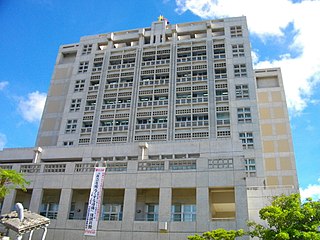
Urasoe is a city located in Okinawa Prefecture, Japan. The neighboring municipalities are Naha to the south, Ginowan to the north, and Nishihara to the east. As of November 2012, the city has an estimated population of 113,718 and a population density of 5,956.9 persons per km2. The total area is 19.09 km2.

Nago is a city located in the northern part of Okinawa Island, Okinawa Prefecture, Japan. As of December 2012, the city has an estimated population of 61,659 and a population density of 288 persons per km2. Its total area is 210.30 km2.

Nishihara is a town located in Nakagami District, Okinawa Prefecture, Japan. In the Okinawan language, nishi means "north", as Nishihara was north of the historical Ryukyuan capital of Shuri.
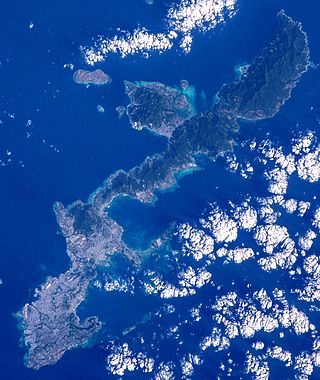
Okinawa Island, officially Okinawa Main Island is the largest of the Okinawa Islands and the Ryukyu (Nansei) Islands of Japan in the Kyushu region. It is the smallest and least populated of the five main islands of Japan. The island is approximately 106 kilometres (66 mi) long, an average 11 kilometres (7 mi) wide, and has an area of 1,206.98 square kilometers (466.02 sq mi). It is roughly 640 kilometres (400 mi) south of the main island of Kyushu and the rest of Japan. It is 500 km (300 mi) north of Taiwan. The total population of Okinawa Island is 1,384,762. The Greater Naha area has roughly 800,000 residents, while the city itself has about 320,000 people. Naha is the seat of Okinawa Prefecture on the southwestern part of Okinawa Island. Okinawa has a humid subtropical climate.

Shuri Castle was a Ryukyuan gusuku castle in Shuri, Okinawa Prefecture, Japan. Between 1429 and 1879, it was the palace of the Ryukyu Kingdom, before becoming largely neglected. In 1945, during the Battle of Okinawa, it was almost completely destroyed. After the war, the castle was re-purposed as a university campus. Beginning in 1992, the central citadel and walls were largely reconstructed on the original site based on historical records, photographs, and memory. In 2000, Shuri Castle was designated as a World Heritage Site, as a part of the Gusuku Sites and Related Properties of the Kingdom of Ryukyu. On the morning of 31 October 2019, the main courtyard structures of the castle were again destroyed in a fire.

The Okinawa Urban Monorail, also known as Yui Rail, is a monorail line serving the cities of Naha and Urasoe, Okinawa, Japan. Operated by Okinawa Urban Monorail, Inc., it opened on 10 August 2003, and is the only public rail system in Okinawa Prefecture. Yui Rail is the first rail line on Okinawa since World War II. As Okinawa is the island of Japan lying farthest to the south and west that has an active rail line, Akamine Station and Naha Airport Station, the southernmost and westernmost rail stations in Japan respectively, lie on this line. It uses the OKICA as its contactless smart card, and integrates with Suica and other major Japanese IC cards from 10 March 2020.
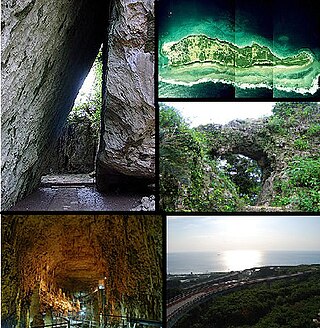
Nanjō is a city located in the southern part of Okinawa Island in Okinawa Prefecture, Japan. Translated literally, the name Nanjō means "southern castle". Many castle ruins, called gusuku in the Okinawan language, can be found throughout the city. The modern city of Nanjō was established on January 1, 2006, from the merger of the town of Sashiki, and the villages of Chinen, Ōzato and Tamagusuku. Nanjō has an area of 49.69 km² and, on the date of its inception, a population of 41,305, and a density of 831.25 per km².

Naha is the capital city of Okinawa Prefecture, the southernmost prefecture of Japan. As of 1 June 2019, the city has an estimated population of 317,405 and a population density of 7,939 persons per km2. The total area is 39.98 km2 (15.44 sq mi)
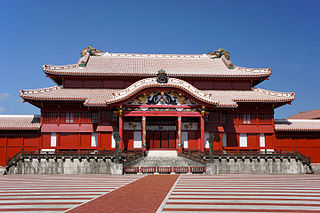
Shuri is a district of the city of Naha, Okinawa. It was formerly a separate city in and of itself, and the royal capital of the Ryūkyū Kingdom. A number of famous historical sites are located in Shuri, including Shuri Castle, the Shureimon gate, Sunuhyan-utaki, and royal mausoleum Tamaudun, all of which are designated World Heritage Sites by UNESCO.
Kumemura was an Okinawan community of scholars, bureaucrats, and diplomats in the port city of Naha near the royal capital of Shuri, which was a center of culture and learning during the time of the Ryukyu Kingdom. The people of Kumemura, traditionally believed to all be descendants of the Chinese immigrants who first settled there in 1392, came to form an important and aristocratic class of scholar-bureaucrats, the yukatchu, who dominated the royal bureaucracy, and served as government officials at home, and as diplomats in relations with China, Japan, and others.
The table contains a comparison of karate styles. Some of the distinguishing features are listed, such as lineage, general form of stances, the balance of hard and soft techniques, and the number and names of kata forms.

Chōshin Chibana was an Okinawan martial artist who developed Shorin-ryū karate based on what he had learned from Ankō Itosu. He was the last of the pre-World War karate masters, also called the "Last Warrior of Shuri" He was the first to establish a Japanese ryu name for an Okinawan karate style, calling Itosu's karate "Shorin-Ryu" in 1929.
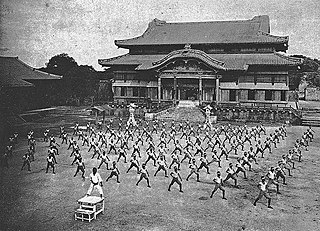
Okinawan martial arts refers to the martial arts, such as karate, tegumi and Okinawan kobudō, which originated among the indigenous people of Okinawa Island. Due to its central location, Okinawa was influenced by various cultures with a long history of trade and cultural exchange, including Japan, China and Southeast Asia, that greatly influenced the development of martial arts on Okinawa.

Shō Shin was a king of the Ryukyu Kingdom, the third ruler the second Shō dynasty. Shō Shin's long reign has been described as "the Great Days of Chūzan", a period of great peace and relative prosperity. He was the son of Shō En, the founder of the dynasty, by Yosoidon, Shō En's second wife, often referred to as the queen mother. He succeeded his uncle, Shō Sen'i, who was forced to abdicate in his favor.
Masami Chinen was an Okinawan martial arts master who formed Yamani ryu. He taught Bōjutsu privately at his home in the village of Tobaru, in Shuri, Okinawa.

Ryūka is a genre of songs and poetry originating from the Okinawa Islands, Okinawa Prefecture of southwestern Japan. Most ryūka are featured by the 8-8-8-6 syllable structure.
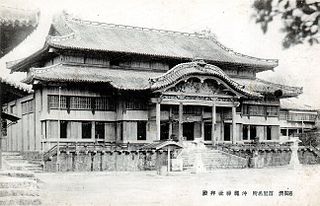
Okinawa Shrine is a Shinto shrine in Naha, Okinawa Prefecture, Japan. Established at the end of the Taishō period on the site of Shuri Castle, the main hall of which was reused as the haiden, the shrine buildings were destroyed in May 1945 during the Battle of Okinawa. Both castle and shrine have since been rebuilt while this phase has been written out of the "official history" currently told at Shurijō Castle Park.
Akata Sundunchi (赤田首里殿内) is a traditional Okinawan song about Maitreya, a Buddhist bodhisattva. The song is named after the Ufuamushirare Temple in Akata Village, part of Shuri, Okinawa.
References
- ↑ "Archived copy". Archived from the original on 2007-09-27. Retrieved 2016-07-06.
{{cite web}}: CS1 maint: archived copy as title (link)